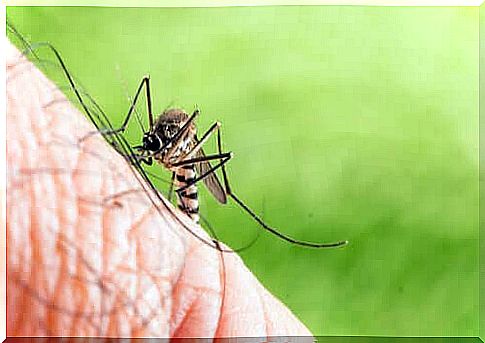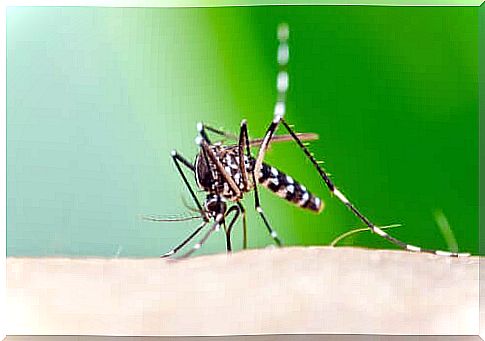How To Recognize The Asian Tiger Mosquito?

The Asian tiger mosquito is a species of mosquito called Aedes albopictus, which belongs to the Culicidae family . Despite being originally from Asia, it managed to spread to practically every continent. What are the characteristics of this insect?
How to recognize the Asian tiger mosquito?
Attempting to recognize the Asian tiger mosquito with the naked eye is often quite difficult, as it is a small insect measuring only 5 or 10 millimeters. Also, the best chance to differentiate it from other species is to look at its body pattern.
This species of mosquito is characterized by its predominant black coloration, with a typical white ornamentation on the abdomen and thorax. In addition, a longitudinal white line that crosses his head and chest can be seen.
Its legs are also distinguished by the black and white bands that compose them. Although this characteristic may confuse them with another well-known and equally dangerous mosquito , Aedes aegypti .
As with other species of mosquitoes, females are the only ones that bite to draw blood and obtain proteins to develop their eggs. Therefore, it is possible to differentiate them by the proboscis, a kind of elongated and thin tube that allows them to penetrate the skin and suck blood.
Origin and distribution of Aedes albopictus
The Asian tiger mosquito is a species native to Southeast Asia. From the late 1970s onwards, Aedes albopictus broke the barriers of its native location and began to spread to other continents.

In less than 50 years, the Asian tiger mosquito has managed to spread to every continent on the planet, with the logical exception of Antarctica. It is not possible to specify how these insects managed to spread so quickly and abruptly, but this phenomenon is probably related to the intercontinental transport of people, plants and various goods.
In the mid-1980s, the Asian tiger mosquito had already arrived on the American continent : it was detected in Brazil, the United States and Mexico. A few years later, it managed to penetrate Central America and the Caribbean as well. In the late 1990s, the insect was also identified in Argentina and Colombia.
Specifically in Europe, the Asian tiger mosquito was first seen during the 2000s. And by mid-2006, the insect had already spread to Belgium, Spain, France, Greece, Holland, Italy, Switzerland, among other European countries.
Concern about its presence in Europe increased after an outbreak of epidemic chikungunya arthritis in Italy in 2007. Until that year, the disease had only been diagnosed in tropical countries, so the phenomenon of globalization of infectious diseases became clear.
Why is the Asian tiger mosquito so harmful?
Currently, the Asian tiger mosquito is ranked as one of the 100 most harmful invasive alien species in the world, according to the list of the International Union for the Conservation of Nature. Its expansion was fast and aggressive, which brought with it an increase in tropical pathologies on the European continent and other anomalous regions.

The main reason why it is considered a threat to public health lies in the fact that it acts as a vector for numerous infectious diseases. The Asian tiger mosquito may be the vehicle for transmitting viral diseases such as dengue, yellow fever, chikungunya and, to a lesser extent, West Nile virus.
It is also important to mention that it is a very resistant species with great adaptability, which explains why it has managed to survive and reproduce in different ecosystems.
The eggs of these insects are able to resist desiccation and remain in a latent state for a long period of time. When in contact with water, dried eggs hatch and give rise to a large number of larvae.
Combat and prevention
Eradication of the Asian tiger mosquito is expensive and very complex due to its incredible reproduction speed and the resistance of its eggs. Therefore, the most effective and viable strategy to control its spread is to invest in preventive measures.
Public awareness campaigns on simple and daily preventive measures, such as avoiding the accumulation of stagnant water, have been showing good results, but need to be intensified.









